Use data to guide intentional spending

Look to the numbers as a guide for where, how to spend one-time money
The homegrown solution
Six ways to cultivate the workforce your district needs
Summer 2022
California Association of School Business Officials
At School Outfitters, we understand that meeting your purchasing rules and regulations is critical to having a hassle-free shopping experience.
That’s why we’re an authorized vendor on co-ops and contracts throughout California.
Our contract specialists have years of expertise navigating school district regulations and state laws.
We’ll answer your questions, find the best pricing for your district and even file compliance paperwork on your behalf.
School Outfitters is an authorized California state vendor on these contracts:
• LAUSD
• San Bernardino County Superintendent of Schools
• San Diego USD
• NorCal JPA
Ready-to-ship inventory
Find the products you need, in stock and ready to ship.
Objective-driven space planning Plan your spaces around your specific educational goals.

Multi-phase project management
Work with experts who know how to manage large, complex projects.
Custom purchase programs
Get custom pricing, products and services for your district.
Hassle-free installation
Tap into our network of reliable installers for customized installation.
2 California School Business Summer 2022
Purchasing compliance, guaranteed We know California rules and regulations What makes us different 1-800-260-2776 | www.SchoolOutfitters.com
It’s no secret that schools and education have changed drastically since Aeries Software began in 1995. We've embraced changes every step of the way and have prided ourselves in being an industry leader in adopting new technologies.


AeriesCloud boasts:


100% API Coverage for ALL functionality within the system

Maximized customizability & scalability








Improved performance, security, and flexibility
Automated test coverage
Longitudinal Database

Customer-Driven features For



Aeries.cloud


more
information visit:

4 California School Business Summer 2022 Piper Sandler California Public Finance Piper Sandler is a leader in providing financial services for California school districts and community college districts. Our team of dedicated K-14 education finance professionals has more than 150 years of combined experience and service to the education industry. We take pride in creating and implementing superior financial solutions for our clients. PiperSandler.com /CAeducationfinance Piper Sandler & Co. Since 1895. Member SIPC and NYSE. Piper Sandler California public finance investment banking offices are located in Los Angeles, San Francisco, Sacramento and Orange County. Timothy Carty Managing Director 310 297-6011 timothy.carty@psc.com Rich Calabro Managing Director 310 297-6013 richard.calabro@psc.com Jin Kim Managing Director 310 297-6020 jin.kim@psc.com Ivory Li Managing Director 415 616-1614 ivory.li@psc.com Celina Zhao Analyst 310-297-6019 celina.zhao@psc.com Mark Adler Managing Director 310 297-6010 mark.adler@psc.com Pam Hammer Office Supervisor 310 297-6023 pamela.hammer@psc.com • General Obligation Bonds • Certificates of Participation • Mello-Roos/CFD Bonds • Tax and Revenue Anticipation Notes • Interim Project Financing • Debt Refinancing/Restructuring Choose
Who Knows California
a
Education Finance Partner



California School Business casbo.org 5 9 CHECKING IN Developing your resilience competency to ‘bounce forward’ Tatia Davenport 11 BOTTOM LINE To be a good leader, prioritize professional networking as a critical business strategy Diane Deshler 12 GUEST FEATURE The key to inclusive leadership Juliet Bourke and Andrea Titus 19 IN FOCUS MEMBER Brad Pawlowski 21 IN FOCUS ASSOCIATE MEMBER Suzanne Gentilini 24 INTERVIEW Robert Kleinhenz He explains how current economic factors can affect school leaders’ decisions and the future of schools Julie Phillips Randles 32 COVER FEATURE Use data to guide intentional spending Look to the numbers as a guide for where, how to spend one-time money Jennifer Snelling 42 FEATURE The homegrown solution Six ways to cultivate the workforce your district needs Jennifer Fink 50 OUT & ABOUT 2022 Annual Conference & California School Business Expo Volume 87 Number two Summer 2022 CONTENTS 42 24 12
ABOUT CASBO
The California Association of School Business Officials is the premier resource for professional development in all aspects of school business. Founded in 1928, CASBO serves more than 24,000 members by providing certifications and training, promoting business best practices, and creating opportunities for professional collaboration. CASBO members represent every facet of school business management and operations. The association offers public school leaders an entire career’s worth of growth opportunities.
CASBO MISSION
As the recognized authority in California school business, CASBO is a member-driven association that promotes ethical values; develops exceptional leaders; advocates for, and supports the needs of, members; and sets the standard for excellence through top-quality professional development and mentorship, meaningful collaboration and communication, and unparalleled innovation.
CASBO BY DESIGN
For the past 16 years, CASBO has been dedicated to the organizational planning discipline as a method for guiding the association into a successful future. Last year, the association completed its sixth such plan, CASBO by Design 2.0, a living, breathing document that guided the association in its long-term planning process, which is grassroots in nature, invigorating in procedure and motivating in outcome. Work on our next strategic plan began in 2021.
CASBO has long been committed to organizational planning because the approach has consistently helped the association envision its future and determine the clear steps to get there. The road map that strategic planning provides has allowed CASBO to remain focused on its unique mission, goals and objectives and to respond effectively to a continually changing environment.
For more information on CASBO by Design, visit casbo.org > CASBO + You > About > CASBO By Design.
Stay connected casbo.org
Publisher
Tatia Davenport
Editor in chief
Joyce Tribbey
Features editor
Julie Phillips Randles
Contributors
Jennifer Fink
Nicole Krueger
Jennifer Snelling
Art Director
Sharon Adlis
Ad Production
Tracy Brown
Advertising sales manager
Cici Trino Association Outsource Services, Inc. P.O. Box 39 Fair Oaks, CA 95628 (916) 961-9999
CASBO OFFICERS
President
Diane Deshler
Lafayette School District
President-elect
Tina Douglas
San Dieguito Union High School District
Vice president
Eric Dill
Carlsbad Unified School District
Immediate past president
Richard De Nava
San Bernardino County Superintendent of Schools
Published June 2022
6 California School Business Summer 2022
California School Business (ISSN# 1935-0716) is published quarterly by the California Association of School Business Officials, 1001 K Street, 5th Floor, Sacramento, CA 95814, (916) 447-3783. Periodicals postage paid at Sacramento and at additional mailing office. Submit address changes online by logging into your account profile at casbo.org.
published in California School Business are edited for style, content and space prior to publication. Views expressed
those
the authors and do not necessarily represent CASBO policies or positions. Endorsement by CASBO of products and
School Business
implied
expressed.
rights reserved. The contents of the publication may not be reproduced by any means, in whole or
part,
written
publisher.
Articles
are
of
services advertised in California
is not
or
Copyright 2022 CASBO. All
in
without the prior
consent of the

California School Business casbo.org 7 CALL 800.462.8328, ext. 4727 EMAIL rpa@schoolsfirstfcu.org Smart business Smart schools ™
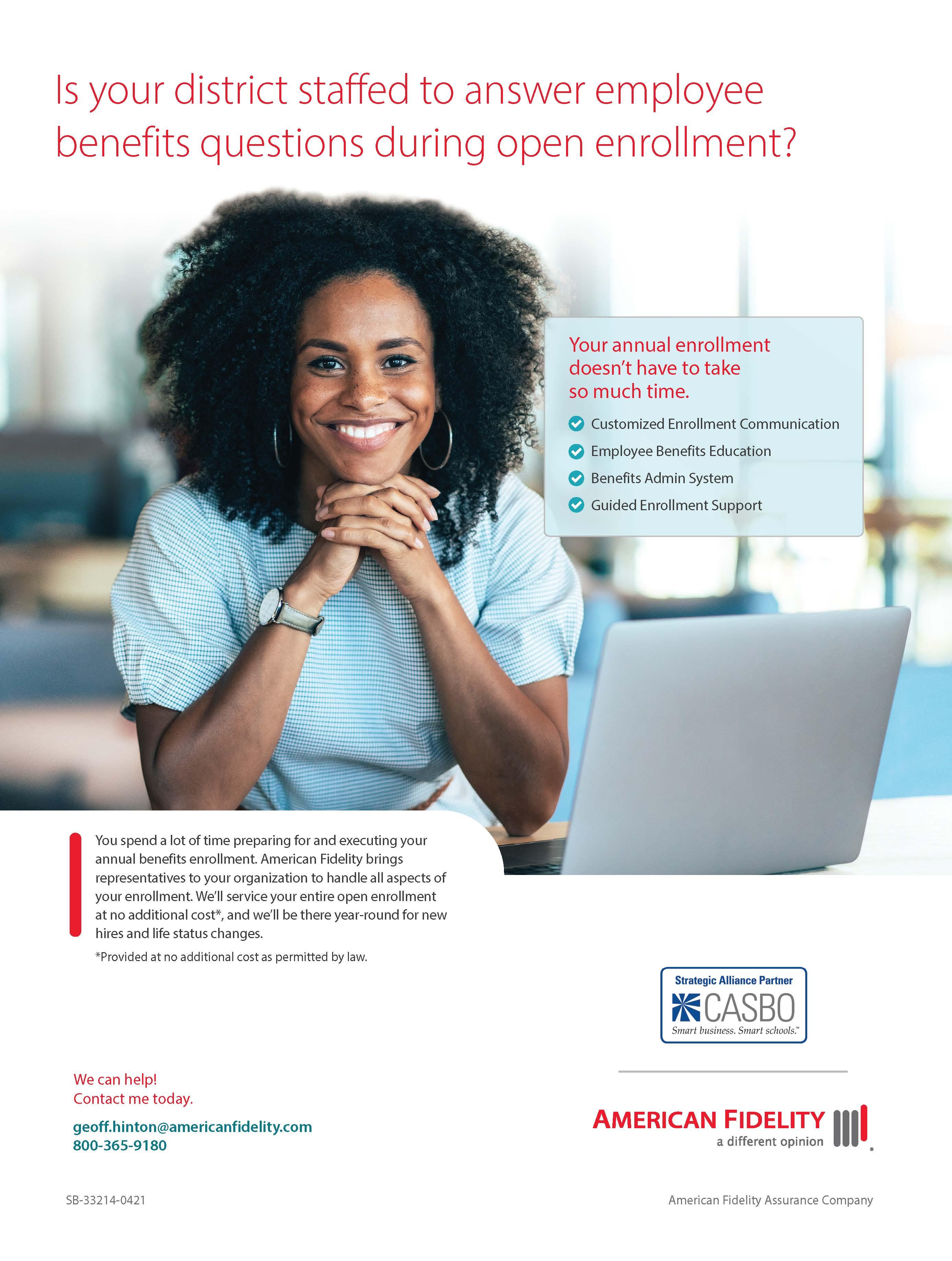
8 California School Business Summer 2022
Developing your resilience competency to ‘bounce forward’
Do you know someone who just has that “bounce back” ability? Their business fails, yet they’ve started to find tremendous success in their next step? They suffered an illness or injury but recovered with grace and are healthier than ever? They experienced tremendous disappointment only to regain their ground and try again?
The more formal term for “bounce back” is resilience. And it’s a competency that each and every one of us should be developing. A competency, in contrast to a skill, that is the combination of knowledge, abilities and attitudes ( plus skill) that helps predict – yes predict – superior performance in the area of resilience.
We’re not born with resilience, though we might naturally have more of it than someone else. By researching those who are considered resilient, such as athletes, survivors and entrepreneurs, a few traits stand out:
1. Resilient leaders stand in the face of the situation with an attitude of action (vs. victimization); they quickly go into motion.
2. Resilient leaders are collaborative; they harness the power and skills of their entire ecosystem to help them navigate the issue.
3. Resilient leaders are empathic; they can identify the emotional aspect of the disruption and aim to reassure, remove fear and calm.
Our ability to be resilient contributes not only to our own health, but also to the well-being, health and overall fitness of our districts. Our local education agency’s ability to respond, adapt and thrive under stress is business resilience, and it can be built through readiness for times of change, crisis or surprise; through risk recognition by enabling systems that alert us to changing conditions; and through a cultural commitment to build the resilience competencies in ourselves and our teams.
We’ve survived a nonstop onslaught of disruptions and transformations – in education, technology, a global crisis and our internal processes – and very few of those were within our control. But it’s imperative that we do more than just survive. We must embrace resilience as a core competency so that with the next crisis or change, we’re able to naturally and effectively “bounce forward.” z z z
Tatia Davenport CEO


California School Business casbo.org 9 CHECKING IN

10 California School Business Summer 2022
WHEN WE SPRINT from meeting to meeting, supporting the needs of students, managing strategic initiatives, putting out fires and handling staffing issues, networking might be the last thing on our minds. After all, don’t we continually feel a shortage of time? Networking feels like a luxury we can’t afford as we’ve carried the weight of so many transitions and changes in our districts.
Over the past two years, haven’t we also had personal moments of reflection to think differently about ourselves and those we lead? All of a sudden, we became beginners again at something such as contact tracing, purchasing PPE, writing safety plans, remote learning, supply and labor shortages. This caused us to quickly realize the emphasis we needed to put on our personal and professional support, resources, insight and feedback that would be critical to our future success.
That professional support, at the most basic level, is networking. While we may not have realized at the time how critical those relational skills were, taking the time to remember and reflect on how well they served us then might motivate us to be more thoughtful and purposeful in prioritizing their expansion now.
But how do we deepen our networking functions when we barely have time to manage our current relationships?
By viewing networking not as a distraction from our “real work” at all, but by prioritizing it as one of our critical leadership strategies. By consciously building time into our schedules to carefully think about where we want and need support … and then creating the network that will provide it.
It might feel awkward and uncomfortable at first, but it’s something all leaders should put into practice because, in combination with solid technical skills, it’s these contacts that provide important information, perspective and support in the form of mentoring or coaching. It’s this lining up of support with and for our stakeholders that helps us diagnose the political landscape and broker conversations among unconnected parties. It’s this activity that lifts the entire profession, resulting in mutual influence.
I made the strategic decision at the CASBO Executive Leadership Forum in May to prioritize building my professional network. I had the opportunity to engage and dialogue with memberleader attendees. I know that these CASBO members and school business experts will provide critical knowledge and
insight that will help make me a stronger leader. One of several new memberleaders that I have the privilege to now include in my professional network is Francine Brissey, director of Purchasing & Warehouse Services at Twin Rivers Unified School District, and chair of CASBO’s Purchasing Professional Council. I feel honored to have made this new professional and personal connection with Francie, and with many of you who attended this Leadership Forum.
As you plan for the next school year, make networking a priority in your strategic plan. Be strategic about where you need to strengthen your network for you and for your staff. Be strategic about building time for it in your schedule.
For some of us, it takes more courage and effort to take the first step in introducing yourself to someone new. Do it, and you will be rewarded with a safe community of peers who, at any time, can effortlessly jump into authentic conversations that mutually benefit all. Consider it an essential piece of your work as a successful leader. z z z
Diane Deshler President


California School Business casbo.org 11 BOTTOM LINE
To be a good leader, prioritize professional networking as a critical business strategy
The key to inclusive leadership
By Juliet Bourke and Andrea Titus
Inclusive leadership is emerging as a unique and critical capability helping organisations adapt to diverse customers, markets, ideas and talent. For those working around a leader, such as a manager, direct report or peer, the single most important trait generating a sense of inclusiveness is a leader’s visible awareness of bias. But to fully capitalize on their cognizance of bias, leaders also must express both humility and empathy. This article describes organizational practices that can help leaders become more inclusive and enhance the performance of their teams.
What makes people feel included in organizations? Feel that they are treated fairly and respectfully, are valued and belong? Many things of course, including an organization’s mission, policies, and practices, as well as co-worker behaviors.
But mostly it comes down to leaders. We find that what leaders say and do makes up to a 70% difference as to whether an individual reports feeling included. And this really matters because the more people feel included, the
more they speak up, go the extra mile, and collaborate – all of which ultimately lifts organizational performance.

Given this formula, inclusive leadership is emerging as a unique and critical capability helping organizations adapt to diverse customers, markets, ideas and talent. Our previous research found that inclusive leaders share a cluster of six signature traits:
1. Visible commitment. They articulate authentic commitment to di-
versity, challenge the status quo, hold others accountable, and make diversity and inclusion a personal priority.
2. Humility. They are modest about capabilities, admit mistakes, and create the space for others to contribute.
3. Awareness of bias. They show awareness of personal blind spots, as well as flaws in the system, and work hard to ensure a meritocracy.
4. Curiosity about others. They demonstrate an open mindset and deep
12 California School Business Summer 2022
curiosity about others, listen without judgment, and seek with empathy to understand those around them.
5. Cultural intelligence. They are attentive to others’ cultures and adapt as required.
6. Effective collaboration. They empower others, pay attention to diversity of thinking and psychological safety, and focus on team cohesion.
This sounds like a laundry list, so it’s not surprising that we are regularly asked which is the most important trait. The answer depends on who is asking. If it’s the leader, commitment is the most critical, because without it, the other five attributes can’t be fully developed.
For those working around a leader, such as a manager, direct report or peer, the single most important trait generating a sense of inclusiveness is a leader’s visible awareness of bias. To underscore this insight: Our analysis of the 360-degree Inclusive Leadership Assessments (ILA) of more than 400 leaders made by almost 4,000 raters reveals that while all six traits are important and operate as a cluster, a leader’s awareness of personal and organizational biases is the number one factor that raters care most about.
Comments from raters on the ILA tell us that they particularly notice, for example, when a leader “constantly challenges (their) own bias and encourages others to be aware of their pre-conceived leanings” or when a leader seeks insight into their biases by, for example, “[Asking] others to test whether their thought process is biased in any way.”
But this is not all. Raters are not looking for a simple acknowledgment of bias, tinged with a fatalistic sense that little can be done about it. They care about awareness of bias coupled with two additional behaviors:
• Humility. Raters want to see that their leaders are determined to address
their biases. Fatalism looks like “Hey, I know I have this prejudice, but whatever, I am what I am.” In contrast, leaders who are humble acknowledge their vulnerability to bias and ask for feedback on their blind spots and habits. For example, one direct report told us that their leader “is very open and vulnerable about her weaknesses, which she mentions when we undergo team development workshops. She shares her leadership assessments openly with the team and often asks for feedback and help to improve.” Our research shows that when cognizance of bias is combined with high levels of humility it can increase raters’ feelings of inclusion by up to 25%.
• Empathy and perspective taking. Raters aren’t looking for their leaders to try to understand their viewpoint and experience as a dry intellectual exercise, but empathically. That means understanding others deeply and leaving them feeling heard. For example, one rater commented “[The leader’s] empathy in interacting with others, makes [the leader] approachable, trustworthy and shows [their] eagerness to work with and/or support peers, colleagues and superiors.” When cognizance of bias is combined with high levels of empathy/ perspective-taking, it can increase raters’ feelings of inclusion by up to 33%.
Why are humility and empathy so important in this context? Humility encourages others to share their feedback (e.g., that a leader might have favorites or have a tendency to interrupt people or regularly ignore a class of information). Empathy and perspective taking gives people hope that a leader cares about them and takes their views into account, rather than barreling on with preconceptions or a narrow set of ideas about their perspectives. Moreover, it creates a sense of personal connection between leaders and a diverse set of stakeholders, making
it easier to make and implement shared decisions.
Putting the traits to work
How can leaders put these insights into practice? One tactic is to establish a diverse personal advisory board (PAD) – a group of people, often peers, who have regular contact with the leader and whom the leader trusts to talk straight. These trusted advisers can give leaders granular feedback on everyday interpersonal behaviors that support or inhibit inclusion, for example: Does the leader give equal time to all meeting participants, or favor those who are co-located over those who have dialed in? Does the leader always refer to one gender when giving examples or both? Does the leader use a broad spectrum of imagery when addressing a diverse audience, or imagery (such as sport metaphors or all male iconography) that represents only one group of people? Because a PAD is ongoing, leaders can receive feedback on whether the changes they make are hitting the mark.
A second tactic is for leaders to share their learning journey about recognizing and addressing biases. We have seen leaders do this by discussing their 360 assessment results with their manager, speaking at a town hall about their growth or creating a standing item in weekly team meetings (“inclusion moments”), during which they or a team member identifies what they have learned that week about diversity and inclusion. These actions express humility, help leaders to test and build on their insights and role model the importance of humility in addressing biases.
A third tactic is for leaders to immerse themselves in uncomfortable or new situations which expose them to diverse stakeholders, for example by attending
California School Business casbo.org 13 GUEST FEATURE
The key to inclusive leadership
an Employee Resource Group meeting, or sitting in different parts of the workplace each week. Exposure, combined with open-ended questions, helps to expand horizons and disrupt pre-conceived ideas.
Inclusive leadership is a critical capability to leverage diverse thinking in a workforce with increasingly diverse markets, customers, and talent. We have previously observed that only one in three leaders holds an accurate view about their inclusive leadership capabilities. A third believe they are more inclusive than they are actually perceived by those around them to be, while a third lack confidence in their inclusive leadership capability and so do less than
they could to actively guide others and challenge the status quo.
Becoming more aware is critical to self-development, but awareness in isolation is not sufficient. Without humility and empathy/perspective taking, it’s difficult for leaders to gain deep insights into the nature of their blind spots or remedial strategies and, therefore, to grow. This requires effort, but fortunately the circle of learning is virtuous. Leaders who are humble and empathetic will be open to criticism about their personal biases, and greater self-insight into personal limitations prompts greater humility, empathy and perspective-taking. Not only are these behaviors critical for leaders’ personal development, they also
serve to make others feel more included along the way. And that is, of course, the objective. z z z
A version of this article appeared in the March 6, 2020, issue of Harvard Business Review. Reprinted with permission.
©2020 Harvard Business School Publishing Corp.
District leaders need easy access to data-based insights that support daily decision making. Frontline Analytics’ suite of tools enables K-12 education leaders to leverage their district, demographic, student, and peer data to make more informed, strategic decisions.

14 California School Business Summer 2022
Make decisions more effi ciently and strategically FrontlineEducation.com Introducing Frontline Analytics, powered by Forecast5
California School Business casbo.org 15





16 California School Business Summer 2022 The equipment you want. A process you trust. Breathe easy From contracting scheduled HVAC maintenance to purchasing all new systems, district purchasers have access to a clear — and compliant — solution. By using competitively solicited contracts, you can access goods and services needed for your facilities faster — helping students and staff stay safer while maintaining a budgeted cycle. Explore contracts to support your needs: sourcewell.co/casbo_facilities Sourcewell is your government source for more than 400 cooperative contracts. sourcewell-mn.gov COLBI's suite of products will keep your team compliant, efficient, and up to date with strong internal controls and real-time reporting. SOFTWARE & SERVICES BY PEOPLE WHO UNDERSTAND SCHOOL CONSTRUCTION Capital Building Program Solutions Software - Service - Training - Controls (714) 505-9544Visit ColbiTech.com Jon Patterson Director of Sales and Marketing JPatterson@ColbiTech.com Contact Us P UTTING CL IENTSFIRS T Contractor Pre-qualification Solutions QualityBidders SM Construction Document Processing and Storage COLBIDocs SM K-12 Bond Program Management Software SM SecureBids SM Online Controlled Bidding and Other Submissions
Let CVT Show You The Right Path.





More Choices and
Value-Added





Benefi ts
Healthcare can be confusing with all the plans, options and variables. Your employees have di erent family healthcare situations and need to have choices, as well as plans, that meet their needs. That’s what California’s Valued Trust is all about. More choices, more options and people to help you and your employees through the complex journey of healthcare benefits.
Contact CVT for a clearer path and peace of mind.
California School Business casbo.org 17
more information, visit www.cvtrust.org or call 800-288-9870
For


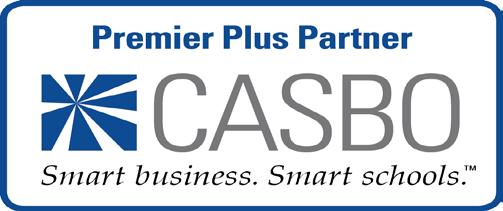

18 California School Business Summer 2022 Big change = big opportunity Help your employees take advantage of the recent changes to Public Service Loan Forgiveness Horace Mann Service Corporation and certain of its affiliates (Horace Mann) enter into agreements with educational associations where Horace Mann pays the association to provide services aimed at familiarizing association members with the Horace Mann brand, products or services. For more information, email your inquiry to association.relations@horacemann.com. horacemann.com AM-C04613 (Oct. 21) Learn more Smart business Smart schools To learn more, go to ww w.amazon.com/k12 Empower teachers Maintain guardrails
Brad Pawlowski
By Nicole Krueger
Working as an air conditioning mechanic in Clovis, where he serviced the same six schools every day, Brad Pawlowski was looking for a new challenge.
After earning a bachelor’s degree in business management and climbing the ranks as a facilities director and chief operations officer, he got the challenge of his career: turning around a financially ailing school district in the middle of a global pandemic.
Pawlowski, a newly minted chief business official, jumped at the opportunity to serve as assistant superintendent of business services for Paso Robles Joint Unified School District, a CASBO organizational subscriber. He didn’t realize until he got there that the district was facing significant financial troubles.

“One of my first presentations to the school board was to tell them our unaudited actuals were complete and our reserve had dropped to below 1%,” he says. “The statutory requirement was 3%, and we were at .96 reserve. Talk about jumping right into the frying pan.”
Pawlowksi, who used to repair air conditioning units on 105-degree summer days in Fresno, is no stranger to a little heat. Although it took significant budget cuts the
whole community felt, he was able to steer the district onto a path toward replenishing its reserve fund.
Then COVID-19 hit. “That just threw a monkey wrench in it for everybody,” he says.
Despite the initial scramble for technology as districts struggled to equip their schools for distance learning, Paso Robles Joint Unified was able to adapt fairly quickly. And with strategic use of its one-time pandemic funding, the district is now sitting on more than 10% in its reserve fund.
“We’ve been able to correct our financial challenges in a very short period of time, and we’re in a much better position right now.”
Pawlowski admits his career path has been unusual, but his background as a mechanic has given him a unique perspective on his role as a CBO. He’s gone from tinkering with the physical innards of a school district to working with numbers in a spreadsheet, and now his job is to transform those intangible figures into tangible things like modernized classrooms, safe buses and daily meals.
“It’s a challenge to take all of that intangible money and turn it into something that our students and staff and community
can all benefit from,” he says. “That’s what I like about it.”
Troubleshooting mechanical problems has also given Pawlowski an investigative mindset and the habit of asking a lot of questions, which has helped him round out his knowledge in the areas of district management with which he’s less familiar. It comes in especially handy at CASBO events, where he makes a point of attending sessions outside his comfort zone.
“As I became a director and moved to chief operations officer, CASBO became so much more important to me. I had other disciplines I wasn’t an expert in reporting to me – food service, for example – and CASBO helped me expand my knowledge. To this day, it’s still doing the exact same thing for me,” he says.
A 2017 graduate of CASBO’s Business Executives Leadership Program, which trains and qualifies school business professionals for certification as a CBO, he also credits CASBO with helping him form a professional network he can lean on when the next challenge comes along.
“I don’t have the answer to everything,” he adds, “but I can probably call somebody who does.” z z z
California School Business casbo.org 19
Photography by Dennis Swanson
He keeps his cool even when financial heat is on
IN FOCUS























































20 California School Business Summer 2022 GERMS SEE A PLAYGROUND. Some see a classroom. Nearly 189 million school days are lost __ every year due to the common cold. _____ _ * KEEP THE HEALTH OF YOUR SCHOOL AHEAD OF THE CURVE. Visit depot.support/healthy-schools or contact your account manager for more details. *Alliance for Consumer Education, 2019 (www.consumered.org/stopgerms). Office Depot is a trademark of The Office Club, Inc. © 2020 Office Depot, Inc. All rights reserved. ACCURACY & TRANSPARENCY in Reporting School Construction Financial Information for Key Stakeholders TRACK. MANAGE. REPORT. Visit us online: www.KeyAnalytics.org Smart business Smart schools
Suzanne Gentilini
She’s cleaning up California’s energy use one district at a time
By Nicole Krueger
When Suzanne Gentilini started working in energy nearly 20 years ago, she knew more about the inner workings of a Girl Scout troop than a building’s electrical system.

“You could have said ‘HVAC’ to me, and I would have said, ‘Gesundheit,’” says the former stay-at-home mom of three girls.
Now, however, her favorite work days are the “jeans and boots” days, when she gets to climb up on school roofs, root around in mechanical rooms and get a little dirty examining old equipment.
“I’m super nerdy. I love to go on site walks,” says the senior manager of business development for ENGIE North America, which helps school districts and other publicsector organizations make the shift to clean energy.
Recently divorced at the time, with a bachelor’s degree in psychology and a work history in sales and human resources, Gentilini was looking for an opportunity to re-enter the workforce when she learned Southland Industries was opening a new energy services division.
She ended up with not just a job, but a newfound passion for energy efficiency.
Solar power was just taking off, and Gentilini became one of its early advocates.
She lobbied to steer Southland toward renewable energy, telling her boss at the time, “Solar is happening. The train is leaving the station. Get on board or get out of the way.”
After facing repeated pushback, Gentilini put out feelers for a job that would allow her to pursue her passion. She landed at Chevron Energy Solutions, which changed hands a few times before it was scooped up by ENGIE, a global company with a mission to achieve carbon neutrality and a CASBO Premier Partner.
“What I love about being here is that their focus is what my passion is: Taking better care of our environment and planet for the future,” says Gentilini.
School districts with aging infrastructure and an interest in solar energy are common in California, but the upfront costs of transitioning can be off-putting for school business leaders who are already struggling to maintain existing equipment. ENGIE solves this problem by helping districts access green energy incentives, write grants and root out other sources of free money. Plus, by reducing districtwide energy demands through infrastructure improvements like efficient lighting and HVAC controls, the company is able to guarantee that a district’s utility savings will
ultimately pay for the project – and even put dollars back into the general fund.
“At CASBO, when I explain how we do what we do, it sounds too good to be true,” Gentilini says. “People have a hard time wrapping their heads around it. But we’re able to come in and show them financially how it’s going to be a benefit to their general fund. Why spend more money on utilities when you can put those dollars back in the classroom?”
To top it all off, ENGIE partners with each district to develop energy-related educational programs, such as student internships or engineering challenges to teach students about sustainability, while exposing them to potential careers in the fast-growing field of clean energy.
Sharing her passion for energy efficiency with a new generation is one of the most rewarding parts of Gentilini’s job.
“It’s really awesome seeing students understand that what’s happening on their campus is meaningful to the greater environment,” she says. z z z
California School Business casbo.org 21
Photography by Allen Zaki
IN FOCUS


22 California School Business Summer 2022
Solutions
StaplesAdvantage.com Technology Solutions I Facility Solutions I Breakroom Solutions I Promotional Products Print & Marketing Services I Business Essentials I Pack & Ship
With decades of experience serving K–12 schools, we make procurement easier. So you can focus on what matters most — your students.
that put students first
PEPPM celebrates 40 years of work soliciting low bids for technology products

PEPPM STARTED ITS WORK conducting sealed competitive bids on your behalf in 1982, when we awarded contracts to low-price bidders on four lines of microcomputers.
Today, PEPPM has grown to award contracts representing millions of bid-protected products, and they are posted on our interactive website at www.PEPPM.org

We’re still the non-commercial, peer-to-peer purchasing cooperative we started out to be, and we’re proud to be today’s premier national technology co-op that is:
• Following best-practice bidding procedures
• Offering most all major-brand technology hardware, software, and furniture
• Transparent, with pricing and documentation posted on our website for registered users
• Compliant with federal Uniform Guidance language that allows you to spend your federal funds
• Operated by a peer educational agency like yours
• Giving you the ability to speedily and legally buy products without having to go to bid yourself
California School Business casbo.org 23
www.PEPPM.org
ESTABLISHED 1982
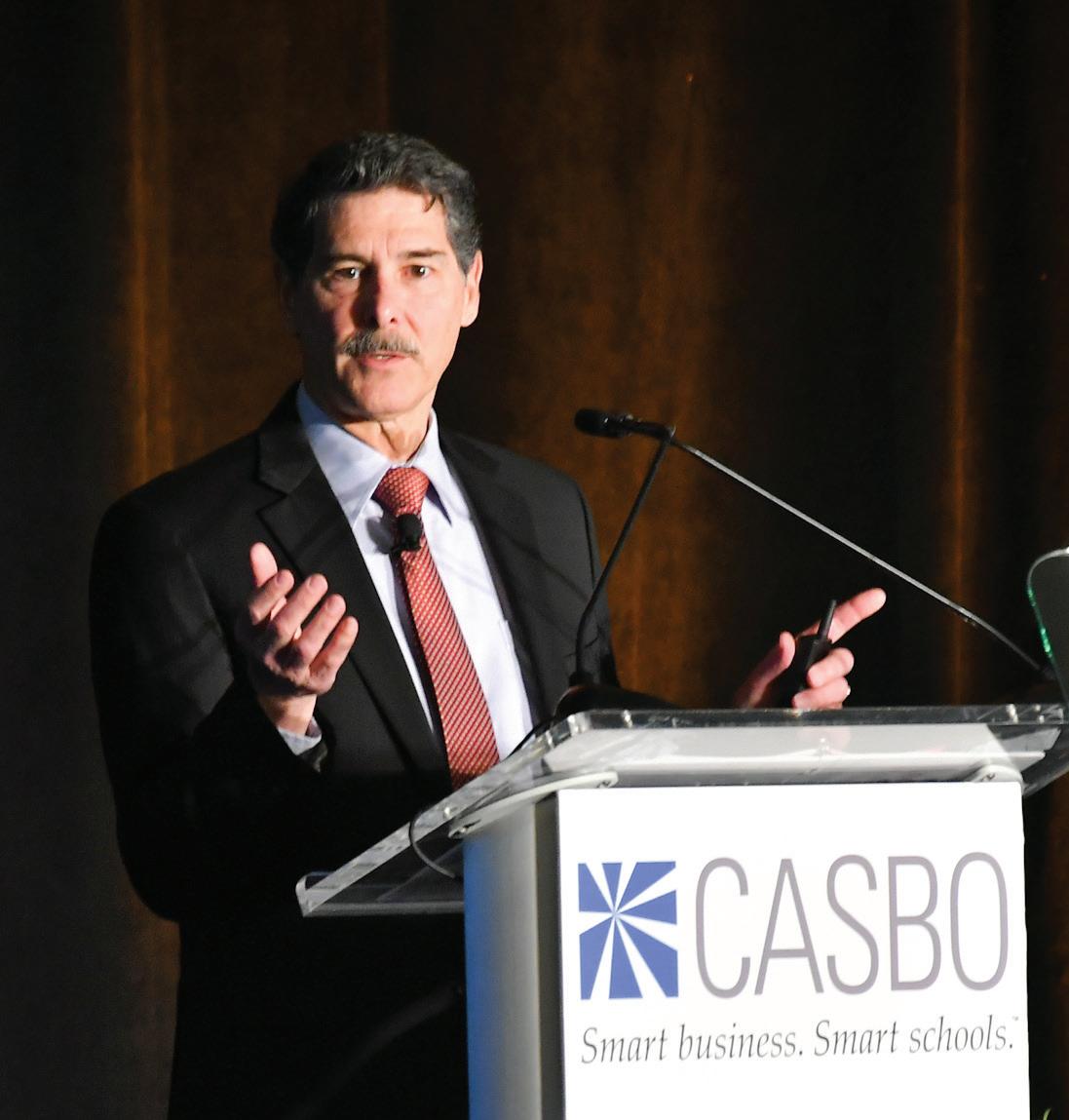


24 California School Business Summer 2022
Robert Kleinhenz
By Julie Phillips Randles
Do you ever wish you had a crystal ball to help you steer your future? Perhaps one that gave you answers to vital questions like how the future of work affects dis-trict hiring, which economic indicators school leaders should focus on, and how to handle enrollment when housing prices are driving out younger families? With that information, there’s very little you couldn’t accomplish.
Robert Kleinhenz is California’s Magic 8 ball when it comes to sussing out these details. He knows the critical data related to the state’s economy. After all, he’s the founder and principal economist with Kleinhenz Economics and has over 30 years of experience as an economist, with a focus on the economics of cities and regions. He’s also an adjunct professor of economics and associate director of the Office of Economic Research at
California State University, Long Beach; senior research fellow with the Inland Empire Economic Partnership; and executive in residence at Cal Poly Pomona’s College of Business.
Previously, he served as chief economist with the Los Angeles County Economic Development Corporation, deputy chief economist at the California Association of Realtors and executive director of Research at Beacon Economics.
He holds a bachelor’s in economics from the University of Michigan, and a master’s and Ph.D. in economics from the University of Southern California, with a specialty in urban and regional economics.
You can trust his numbers, as CASBO school business officials who heard him speak at the Economic Summit at CASBO’s 2022 Annual Conference & California School Business Expo last
spring will vouch. Kleinhenz has a long history of partnering with CASBO, having presented at Annual Conference and CBO Symposium for nearly a decade.
“At times like these, you have to look beyond headline numbers to get a better sense of where the overall economy is moving,” Kleinhenz wrote this year for the Inland Empire Economic Partnership. “When you look beyond the headline numbers, you find that much of the economy is making progress in the recovery phase and the picture is more encouraging.”
In short, Robert Kleinhenz knows things that are incredibly consequential.
So we sat down with him to make sense of the current economic numbers in California and focus in on school leaders’ specific concerns.
California School Business casbo.org 25
He explains how current economic factors can affect school leaders’ decisions and the future of schools
INTERVIEW
Robert Kleinhenz
What’s the best advice you received and who gave it to you?
“The future doesn’t happen, it’s created!” as said by a speaker at an event where I was also presenting.
What are you reading right now?
I love to stay on top of current events, news, science and technology, partly because my work requires it, but also because we live in a fast-changing world, and I want to know what’s happening. Aside from that, I like to read history, but it’s been a while since I have done so. The last book I read was “World Order” by Henry Kissinger, about a year ago.
With issues of labor force availability in mind, and as discussed in a feature article in this issue, how can school districts attract employees to the field when they’re competing with fields like health care, which offers positions that don’t require college degrees?
Employers across all industries will be facing staffing challenges over the next few years, including school districts. It’s important to recognize that we will have a “homegrown” workforce over the foreseeable future because the cost of living in California is a deterrent to people who relocate from state to state. That’s not to say it does not happen. In fact, we do have people moving here, but they tend to be better educated and have higher incomes.
Setting migration aside then, our workforce over the next 10 years will predominantly be the product of K-12 and higher education here in the state of California. It’s incumbent upon us as a state to prepare today’s students for tomorrow’s jobs. But tomorrow’s jobs will morph from today’s occupations. Automation and artificial intelligence will play a greater role in the workplace but won’t so much displace jobs as they will
perform certain functions or tasks that people will no longer have to undertake.
It’s inevitable that our workforce of tomorrow will need more technical skills than the workforce of today and will need to be adaptable to the fast pace of change in our world and economy. That means individuals very likely will do more than complete a basic education over their working careers. They will likely return to education and training institutions to refresh skills or renew themselves. This is already happening but may become even more widespread over the next few years.
As I see it, school districts have a front-row seat on the situation. Individuals spend more time in K-12 institutions than any other education or training environment. So, the question in my mind is, to what extent might school districts be able to create a template that connects their future workforce needs to the education and training community? In my experience, that linkage in the workforce/talent pipeline is one of the most difficult to establish. Given their role in the workforce/talent pipeline, maybe school districts can create a template that other industries can model.
The question above extends to talk in the education field about promoting career-tech education (CTE) for students. What about the districts themselves? What can they be doing to grow or provide CTE-related jobs?
First, we need to be more nuanced about the message we deliver to students and their families about their future roles in the workforce. More and more jobs will require technical training in the future, but that does not mean everyone needs a college degree. Second, looking at the confluence of demographic and technological trends, the number of school-age kids in California may decline over the next few years, but the need for
26 California School Business Summer 2022
It’s important to recognize that we will have a “homegrown” workforce over the foreseeable future because the cost of living in California is a deterrent to people who relocate from state to state.
lifelong learning on the part of adults will grow. K-12 institutions may need to shift resources toward the delivery of adult education and CTE in the coming years and may need to enter into partnerships with employers as a part of that shift.

What can you share about the future of work and how that will affect hiring by school districts, both when it comes to teachers and school business leaders?
Automation will not displace teachers and school business leaders, but it will change the way they work in the coming years. As mentioned earlier, technological change will cause tasks and functions
to evolve more than they will displace occupations.
Think of how Scantrons have changed the way people grade exams. That function has become “automated” in a 20th century sort of way, but it frees up the teacher’s time to do other things, hopefully creating more “value added” in the classroom.
And in the business setting, think of how Microsoft Excel and other applications have changed the way people track and manage business information. It has increased the efficiency of that task, enabling the business leader to focus on other things. One can only
California School Business casbo.org 27
As I see it, school districts have a front-row seat on the situation.
Robert Kleinhenz
imagine the changes that will materialize in the coming years and the ways they will affect the work and classroom environment.

Our readers are preparing for the new school year. What should they expect on the economic front this fall?
There are worries that the U.S. economy might tip into recession sometime “soon” because of inflation, rising interest rates (both market-driven and induced by actions of the Federal Reserve Bank) and high energy prices. Let’s look at the data.
The unemployment rate is now at 3.6% and the labor market is very tight. Job creation is occurring at an impressive pace, driving income gains, and in turn heightened demand for products and services. Higher prices are market
responses to heightened demand and constrained capacity. The same is true of interest rates. Of course, the Fed is raising key policy rates and making other adjustments to slow the growth trajectory of the economy. If it overcorrects, we could see a recession at some point in the future. Hopefully, it will keep its finger on the pulse.
As for high energy prices, they are far less likely to cause a downturn than has been the case in the past. We’re less energy reliant in 2022 than we were in previous decades.
Putting all this together, we are looking at a tight labor market over the indefinite future, and we may need to get used to a slightly higher long-run inflation rate than the historically low rates we have seen over the last couple of decades,
28 California School Business Summer 2022
California’s economy should track closely with, or even outperform, the U.S. economy over the near future.
but a downturn over the next 12 months or so seems very unlikely unless the Fed overtightens.
Finally, California’s economy should track closely with, or even outperform, the U.S. economy over the near future. The state is looking at a large budget surplus this year, as everyone knows, but the next couple of fiscal years could be quite different.

As a data guru, what economic indicators and other data should school leaders focus on when it comes to making decisions? What resources can you recommend?
I have three recommendations:
• Find a national commentator whose perspectives align with yours consistently and follow what they are saying. I listen to Mark Zandi of Moody’s Analytics and Jamie Dimon of Chase. I also keep an eye on national forecasts from the University of Michigan and Wells Fargo and rely on UCLA for the state outlook.
• Find a local source – a good business news reporter (they are definitely in the major metro areas but also in smaller regions) or a local institution like a university that produces a regular regional forecast. You’ll need to connect the dots from national to state to local.
• The final connection is from U.S./ state to your school district, which is something your planning team should be doing with several planning horizons: 1-year, 3- or 5-year and 10-year.
How do local education agencies attract/retain a local “homegrown” workforce when many today can’t afford to live in the communities they grew up in?
That’s a tough problem. California needs more housing, but many communities around the state have been slow to add new housing. That’s why the state has
become more forceful about holding cities accountable. Employers identify the high cost of housing as an impediment to hiring a competitive workforce. We’re the fifth largest economy on the planet, and we need to do a better job of increasing the stock of housing so we can make the state a more affordable place to live if we want to maintain that position.
If most people now need advanced degrees to make the minimum income level that allows them to buy even a median-priced home, how does the state minimize the effects of declining enrollment precipitated in part by droves of young families leaving the state because they can’t afford housing? Net domestic migration was -277,000 in 2021, so that’s the number of people who left California last year. That’s a decline of 7/10 of one percent. People are not leaving in droves. It’s more like a trickle. Some may be young families, but there are also retirees who move for economic
reasons, and there are other noneconomic reasons for population moves. So, if we are looking at cause-and-effect, I’m much more concerned about the cause: We are not building enough housing. Let’s focus on solving that problem and population movements will take care of themselves. z z z
Julie Phillips Randles is a freelance writer based in Roseville, California.
California School Business casbo.org 29
WE GE T THE CLASSROOM LOOKS DIFFERENT.
To transform learning through cloud technologies, you need IT Orchestration by CDW®.
The cloud helps keep classrooms connected — no matter where learning takes place. From secure, real-time collaboration among students to enhanced workflows for administrators, see how CDW can help your organization leverage cloud technologies and accomplish more every day.

See how at CDW.com/education
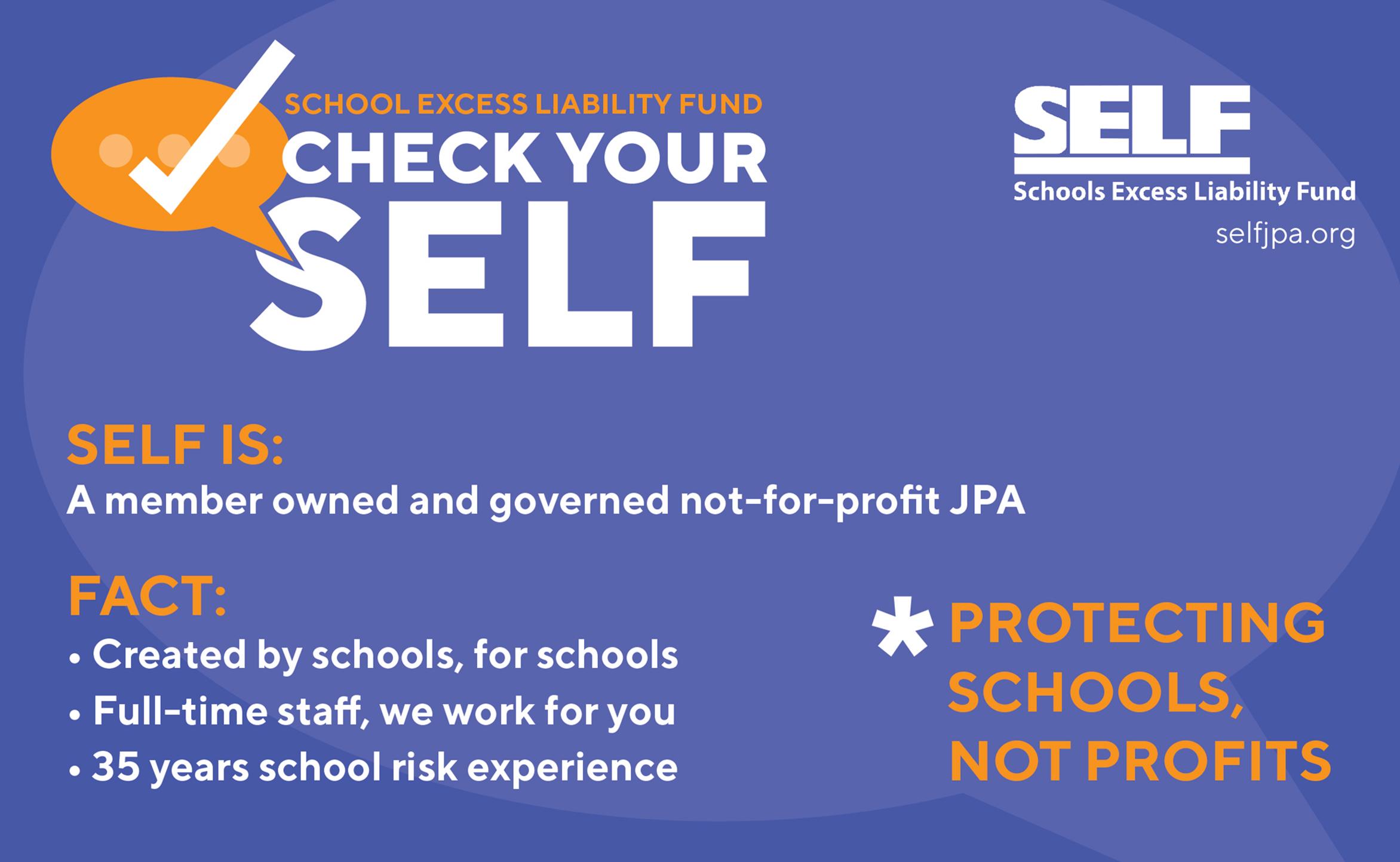
30 California School Business Summer 2022
Smart busi Smart schools. Education
Service is at the heart of who we are.
It’s our highest aspiration.
Over 450 California public school districts have joined together to make SISC what it is today.
We have a 42 year history of providing our members with coverage for workers’ compensation, property and liability and health benefits.



Districts join SISC for our consistently low rates, but they will tell you our service is the reason they stay for decades.

We’d love to serve you, too.
Interested in membership?
Let’s talk. Call us at (800) 972-1727 or visit www.sisc.kern.org.
California School Business casbo.org 31
A Joint Powers Authority administered by the Kern County Superintendent of Schools Office, Mary C. Barlow, Superintendent

USE DATA TO GUIDE INTENTIONAL SPENDING

Look to the numbers as a guide for where, how to spend one-time money
By Jennifer Snelling
COVER FEATURE
SCHOOL BUSINESS LEADERS know more than anyone how unpredictable and difficult the last few years have been. Thankfully, there’s federal financial assistance in the form of one-time funds to help schools navigate the uncertainties and increased needs of the pandemic.
Now, CBOs and CFOs have the difficult task of determining how best to spend those funds to help those students most affected. What are the economic issues facing schools? What issues do we have data on that can help guide spend-

ing decisions? What opportunities do the new funding and our understanding of needed school reforms create?
Emma Dorn of McKinsey & Company advocates looking for opportunities to make schools more equitable and successful at their core mission.
“Crises often create an opportunity for broader change, and as education systems begin to make decisions about investments for the new school year, it’s important to step back and consider the longer-term imperative to create a better system for every child beyond the
34 California School Business Summer 2022
USE DATA TO GUIDE INTENTIONAL SPENDING
Data is the perfect place to start the decision-making process.
pandemic,” writes Dorn with co-authors Jake Bryant, Stephen Hall and Frédéric Panier in the article “Reimagining a More Equitable and Resilient K-12 Education System.”
Just how do we do that? By recommitting to what we know works and innovating with intention through the use of data.
Data is the perfect place to start the decision-making process, agrees Jeff Carew, director of business development for CASBO Strategic Alliance Partner Forecast5 Analytics, now part of Frontline Education.
“We’ve never come out of a crisis like this. We need to rely on professional networks and regional meetings, and engaging in collaborative conversation is a must,” Carew says. “Sharing information with comparable districts enables them to ground their decision-making process in solid data. Right now, more than ever, no one should be going it alone.”
To understand how to analyze and use data, Carew suggests district leaders ask three questions:
1. How are they doing?
The California School Dashboard makes it easy to assess how all the different subgroups of students are faring.
2. How do we compare?
“The best CFO leaders have multiple peer groups to look at,” says Carew. “Districts in the region, similar in population, those with challenges. It’s an opportunity to see ideas to make changes in operation or showcase how well they’re doing in a particular area.”
3. What does the future look like?
This means using data to build a forecast, run comparable scenarios and communicate those scenarios.
“That third question is so important right now. With the one-time money, we have to build scenarios of when we move back into that regular revenue environ-
ment,” says Carew. “We need to plan the runway landing instead of dropping off the fiscal cliff.”
THE MONEY
Schools have two significant considerations for decision-making right now: data and available money. Let’s start with what we know about available money. The state general fund has provided a record level of funding for local education agencies (LEAs) in the last two years. Yet, recent history teaches us that California has one of the most volatile tax systems in the country, as Matt Phillips, director of Management Consulting Services for CASBO Premier Partner School Services of California, Inc., points out. For example, the state budget topped out at a record $220 billion in January 2020, but four short months later, California schools faced cuts just as they struggled to reopen.
“If you’re wondering why your chief business officer is always worried about what’s on the horizon, it’s not that they’re worried – they’re remembering,” Phillips said in the Economic Summit held at CASBO’s 2022 Annual Conference & California School Business Expo last April. “The reality is nobody knows when, or how long, or how deeply, the next recession will impact California.”
That said, the state has tools to help schools:
1. One-time revenues.
The governor continues to invest heavily in one-time programs, with a total of more than $6 billion.
2. Reserves.
The state’s Proposition 98 reserves are healthier than ever at $9.7 billion.
3. Untapped deferrals.
The state’s deferrals have been fully repaid, meaning this is an available tool where the state has $12.9 billion.
California School Business casbo.org 35
Sharing information with comparable districts enables them to ground their decisionmaking process in solid data. Right now, more than ever, no one should be going it alone.
4. “Full” school year. The Great Recession resulted in financial flexibility by reducing the number of school days required for a “full” school year. This option is a last resort because it directly impacts students.
WHAT WE KNOW
Now, what do we know from the data? The following is from Curriculum Associates i-Ready Assessment data:
• By the start of the 2021-22 school year, students were on average four months behind in math and three months behind in reading in grades 1-6.

• In a typical classroom of 30 students, three additional students could be two or more grade levels behind this year.
• The gap between students in majority-Black schools and in majoritywhite schools is now three months wider than it was prior to the pandemic.
And there’s this from a McKinsey survey of parents in November 2021, as shared in their report titled “COVID-19 and education: An emerging K-shaped recovery.”
• We know that California students had some of the lowest access to inperson instruction during the 2020-21 school year. And that a majority of parents are aware of that.
• We also know that California parents are concerned not just about academic performance, but also engagement with school and their child’s mental health.
• California parents, more so than parents in other parts of the country, know about the above issue. Parents of Black, white and Hispanic children show higher levels of concern in California than in the U.S. as a whole.
• Parent reports of chronic absenteeism have increased more than two times since before the pandemic.
36 California School Business Summer 2022
USE DATA TO GUIDE INTENTIONAL SPENDING
The reality is nobody knows when, or how long, or how deeply, the next recession will impact California.
In addition to these studies, California’s State Dashboard provides a wealth of granular data about individual schools, says Phillips. “When we talk about data to make decisions, that has to be at the core of any decision-making. With this one-time money, we don’t want to get into ‘solution-itis’ where we come up with a solution not understanding how it will fix the problem. Use the data from the dashboard to identify where the largest gaps are.”
For instance, we know that subgroups that were already falling behind, African Americans, special needs, the homeless population and foster kids, and can see that those groups fell further behind.
Elizabeth McClanahan, director of purchasing and warehouse for Mt. Diablo Unified School District, offers an example of how complicated the calculations can be. “Due to the pandemic, our students need extra support both academically and emotionally, as seen with our Social Emotional Learning Survey, through focus groups, and analyzing student behavior and attendance,” she says.
“We have been able to handle these current expenditures due to our one-time funds, but the long-term ramifications of the pandemic and the heightened needs of our students, coupled with our anticipated California student count funding drop, will significantly impact how we address student needs in the future. Unless school districts’ ongoing funding is increased, positions built into one-time funding will either be eliminated or built into ongoing budgets which may cause a structural deficit moving forward. In order to stay solvent, this situation would trigger reductions and eliminations in these supplemental areas to cover the essential needs.”
McClanahan and Mt. Diablo Unified are already doing many of the things that Dorn recommends. Based on the data collected by McKinsey & Company and other sources, Dorn and her co-writers suggest focusing on high-quality, inperson education; using data to determine a more equitable distribution of resources; and focusing on the whole child.
HIGH-QUALITY, IN-PERSON EDUCATION
Mt. Diablo Unified is using its one-time funding to give students the support and encouragement needed to boost student achievement.
“We have been able to offer our students online and in-person tutoring and academic support,” says McClanahan. “We have also been able to offer our teachers professional development that helps them target and support the students that are struggling. [We’ve] also been able to hire counselors to support student emotional and academic goal needs, something our district has wanted to do for some time.”
Of course, the lack of data from the last couple of years also delays the inevitable. We are just now seeing that students are falling further behind than we initially thought.
“It’s hard to achieve excellence without data on current performance and benchmarks to aim toward,” says Dorn. “However, data should be used primarily to inform – to direct support to the students, teachers and schools that need it most – not to punish. ... Formative assessment becomes even more critical.”
The pandemic demonstrated what many of us already knew: high-quality, in-person education is vitally important to student success. And that high-quality, in-person education is impossible without teachers.
California School Business casbo.org 37
When we talk about data to make decisions, that has to be at the core of any decision-making. With this onetime money, we don’t want to get into ‘solution-itis’ where we come up with a solution not understanding how it will fix the problem.
“Research backs up what many of us know to be true: Children learn best from people, not programs,” says Dorn. “While greater use of technology in education may be inevitable, technology will never replace a great teacher. High-performing school systems understand that and invest in both recruiting and helping top talent become effective teachers.”
There is a significant amount of one-time funds and ongoing dollars to mitigate learning loss or expand learning opportunities. As every human resources person knows, finding someone to fill the vital roles of teacher and tutor is very difficult right now.
“For me, the challenge is not so much an economic issue, meaning there is no funding to support initiatives. Right now, it’s a people issue. You could use the data from the dashboard and have the best idea, but it’s about finding qualified people who can implement those ideas,” says Phillips.
As exhausted educators look for other jobs, offering retention bonuses, hiring bonuses for high-need areas or bonuses for referring someone are good uses of those one-time funds.
It’s also essential to understand how to stay competitive in the hiring marketplace. Diving into locally collected wage data and the hourly wage level can help better understand the market rate. Obtaining this data will require collaboration with local agencies.
Of course, money doesn’t always buy people. People want to work where they feel like they are being effective and making a difference. Dorn suggests investing in professional development that helps teachers be more effective. In addition, school districts should examine where teachers spend their time and free them to spend more time in direct engagement with students.
MORE EQUITABLE DISTRIBUTION OF RESOURCES
We’ve also learned a lot during the pandemic about making education more equitable for all students. Steven Q. Cornman, a statistician for the National Center for Education Statistics, studied the expenditures of public elementary and secondary districts in 2015-16 and found that the average high-poverty school receives $500 less per student each year than the average low-poverty school does.
There’s an opportunity to use pandemic budget funds to fill in gaps to further academic and equity success. This could look like using Google Maps data to identify where students who need extra resources live and targeting funds to schools in those areas, says Carew.
The Expanded Learning Opportunity Program is an ongoing funding source and requires LEAs to provide a ninehour day for students in grades TK-6. This “wraparound day” is defined as “opportunities to engage pupils in enrichment, play, nutrition and other developmentally appropriate activities.” Additionally, the state is allocating additional funding to implement Universal Meals.
“The horizon is bright because the governor, legislature and school districts recognize we need to do something different for students,” says Phillips. “The push to offer a nine-hour day is wonderful and needed.”
It could also mean embracing technology to expand access and personalized education and better preparing students for the future of work by focusing on digital literacy.
For instance, McClanahan says, “The pandemic fast-tracked our technology goal of 1:1 (device to student) district-
38 California School Business Summer 2022
There’s an opportunity to use pandemic budget funds to fill in gaps to further academic and equity success.
USE DATA TO GUIDE INTENTIONAL SPENDING
wide. We shifted one-time funds to cover this launch for both our students and teachers. Many smaller expenses have been moved over, when appropriate, to maximize this funding and release our general funds for other purchases we would not normally have been able to afford.”
FOCUS ON THE WHOLE CHILD
The emotional toll of the COVID-19 pandemic means that schools must address anxiety, depression and other mental health issues before students are ready to learn.
“It’s a reminder that schools need to address the whole child, helping them
develop skills and awareness beyond what they need simply to find work,” says Dorn.
Unlike test scores that provide clear data, it’s not that easy to know what’s going on in students’ minds. “When it comes to identifying students who have fallen off track, delivering resources to get back on track, meeting social and emotional needs to help students –those are the hard questions,” Carew says.
He suggests getting creative around data collection. Some districts are doing surveys asking if students are comfortable returning to school. Tapping into local knowledge, such as nonprofits that help families in need, and collaborating

California School Business casbo.org 39
Unlike test scores that provide clear data, it’s not that easy to know what’s going on in students’ minds.
RESOURCES TO HELP YOU BECOME A DATA GURU

TAKE A DEEPER DIVE INTO HOW TO BETTER ANALYZE AND USE DATA BY SPENDING SOME TIME WITH THESE RESOURCES:
• California School Dashboard (caschooldashboard.org)
• i-Ready Assessment (bit.ly/38siEhk)
• McKinsey’s “COVID-19 and education: An emerging K-shaped recovery” (mck.co/3wtHxRA)
• National Center for Education Statistics (nces.ed.gov)
• CASBO NewsBreak: Governor Newsom Releases the May Revision Budget (bit.ly/3wEoqV8)
with other districts who already have data are other options.
Engaging with families is an important part of connecting with the whole child. Data can help with this, too. All over the nation, stakeholders question every move a school district makes. Here, CBOs have an opportunity to increase credibility by demonstrating how they are using data in decision-making. Be transparent about data, key performance indicators and where the district implements best practices.
“We found in COVID that transparency is a necessary part of a
CBO’s job,” says Carew. “We have to tell the story and, more importantly, use data to tell the story.”
Now’s the moment that school leaders have been waiting for in many ways – opportunity and money to transform some of education’s most complex challenges. At the same time, many are still dealing with changing public health guidelines, angry parents and uncertainty about the future of funding. It’s challenging to find the capacity for strategic planning amid the daily tumult.
“We all have to recognize that people are tired,” says Phillips. “But we only
have students for 13 years, and we’ve lost two years of that. It’s incumbent upon all parties to help make up that loss of learning.” z z z
When have you used data to make decisions in your district? Share your examples at LinkedIn/CASBO.
40 California School Business Summer 2022
Jennifer Snelling is a freelance writer based in Eugene, Oregon.
USE DATA TO GUIDE INTENTIONAL SPENDING



California School Business casbo.org 41 Get moving on critical projects Let us take care of the financing, so you can focus on the project at hand. The Certificates of Participation and Lease Program can assist you with raising the capital funds you need to get moving on your highest priority property acquisitions, classroom construction projects, equipment purchases and more. Contact us to find out more 800.266.3382 ext. 2603 | www.csba.org/cop Our program offers: » Fast and efficient financing » Non -bonded debt » Competitive interest rates » Tax-exempt payments » Full asset ownership California School Boards Association | 3251 Beacon Blvd. West Sacramento, CA 95691

The homegrown solution
Six ways to cultivate the workforce your district needs
 By Jennifer Fink
By Jennifer Fink
Still running ads for “experienced payroll clerks” or “experienced bus drivers?”
It’s time to pull ‘em.
If your district needs payroll clerks, bus drivers, child nutrition workers or other employees, you can either waste time (and money) searching for candidates with niche experience, or you can hire someone with general skills and train them for the job.
“People often spend months running an ad when they could instead hire someone with basic competencies and train them up,” says Tatia Davenport, CASBO’s chief executive officer. “That’s what we believe the future holds when it comes to resolving the worker shortage, and CASBO is committed to providing the training and support your organization needs for those employees.”
The worker shortage, of course, is not news. But contrary to public discourse, it’s not primarily a result of the COVID-19related “Great Resignation.” Rather, the current hiring climate is the result of demographic trends that were in place even before the pandemic, says Robert Kleinhenz, principal economist at Kleinhenz Economics, and associate director of the Office of Economic Research and adjunct professor at California State University, Long Beach.
California School Business casbo.org 43 FEATURE
The homegrown solution
“Older members of the workforce who are at or near retirement age are going to be leaving the workforce pipeline in larger numbers than the size of the cohort entering the pipeline,” Kleinhenz says. “It is conceivable that the workforce will become tighter as we move forward this decade.”
Historically, California has experienced positive net migration. That pattern is changing, however, so school districts (and other industries) can’t count on filling open positions with new residents from other states and countries.
“There is no guarantee that workers are going to be here when they’re needed, so employers have to think about what’s going to be required to ‘home grow’ their workforce,” Kleinhenz says.
Not sure where to start? Try these ideas:
Set aside time to focus on workforce development
Just as you allot time to fiscal analysis and budget development, you need to set aside dedicated time to concentrate on workforce development. A reactive approach to hiring won’t work in today’s highly competitive climate; if you don’t start looking for candidates to fill positions until your current employees announce their intention to move on, you’re already behind.
The only way to successfully home grow a workforce is to thoughtfully and deliberately analyze both your current and future needs, considering known demographic and fiscal trends. Tap into available data; it’s there.
“We have more information than ever before about workforce needs and occupational projections,” Kleinhenz says. “We can harness that info to match up those future workforce needs with the
requisite education and training requirements.”
Keep in mind this slightly scary fact: Today’s fourth graders are the ones who will be entering the workforce in approximately 10 years. Share your anticipated needs with local community colleges, technical schools and universities, as these institutions can provide much of the education and training your future workforce will require. Without these conversations, you may find yourself in an uncomfortable gap in a decade or so, as the available pool of employees may not be able to access necessary training.
“Often the missing piece is face-toface conversations between prospective employers and other people in the training pipeline,” Kleinhenz says. “Educational and training institutions need a clear idea of both the number of positions that will likely be required going forward and the type of training needed.” Without that information, post-secondary educational institutions may not have the available staff and resources to educate prospective employees.
Dialogue between school districts, county offices of education and postsecondary education programs must be ongoing, as needs will evolve over time.
Specify future workforce needs
It’s not enough to say, “We’ll need payroll clerks, a transportation director, child nutrition workers, IT specialists and someone who specializes in risk management.” To home grow a workforce, you must get super specific and identify the precise skills you’ll need.
“A nuanced approach is necessary,” Kleinhenz says. “When we look at trends in automation and artificial intelligence and how they displace workers, we can see that they don’t really displace jobs; they displace tasks.”
44 California School Business Summer 2022
Just as you allot time to fiscal analysis and budget development, you need to set aside dedicated time to concentrate on workforce development.
He recommends first identifying likely position needs and then outlining the specific functions and tasks typically involved in those positions. Some of those tasks may not be necessary within 10 years; some you may be able to fulfill with artificial intelligence or automation. The remaining tasks and functions are things you can begin training for and developing right now.
“If collaboration is a core competency for a position, think about what skills – like managing conflict, interpersonal savvy and building networks – need to be developed,” says Davenport.
Breaking positions down into specific tasks and core competencies can also help you differentiate between “must-have” and “nice-to-have” skills.

Get creative
Like many districts, CASBO Organizational Subscriber San Dieguito Union High School District struggles to hire child nutrition workers and bus drivers, in part because these positions are typically less than full-time, involve odd hours and don’t offer a benefit package. So the district is getting creative. They are increasing some child nutrition worker positions from 2.5 hours per day to 4 hours per day so workers will be eligible for benefits, says Tina Douglas, the district’s associate superintendent of business services and CASBO’s president-elect. That’s possible because the district has benefited financially from the recent influx of funds from the federal government to support student nutrition.
The district is also exploring ways to get bus drivers on the payroll more quickly. Generally, drivers must complete a six-week training program, including behind-the-wheel training, and pass tests from both the California Division of Motor Vehicles and California Highway Patrol before they can be added to the district payroll and begin earning money. Two months of unpaid training in a tight job market equals very few people interested in working as bus drivers.
“We’ve had bus driver classes start out with 13 participants and by the time the class is done, we’re down to seven,” Douglas says. “It’s hard to keep them here when there are so many other jobs out there where they don’t have to wait to get their first paycheck.”
California School Business casbo.org 45
The homegrown solution
To address that issue, the district’s board of education recently approved a plan that will allow would-be bus drivers to drive school vans – and earn income –before they earn their bus driver’s license. “This way, they’re at least on the books and getting paid while they’re going through training,” Douglas says. “We’re hoping that will help us with the bus driver issue.”
The district is also open to combined positions – say, an individual working in both child nutrition and transportation, or transportation plus facilities and maintenance & operations.
Identify internal superstars
Right now, there are people in your district with untapped potential. One of the best ways to grow your own workforce is to identify and nurture the potential of current employees.

“You may have an internal superstar who doesn’t realize they’re one until you ask or get to know them,” says Aaron Heinz, deputy superintendent at the Colusa County Office of Education, also a CASBO organizational subscriber. “Maybe they’re good at numbers or budgeting, but it’s something they hadn’t really thought about it as something they could do professionally.”
San Dieguito Union’s Douglas was so impressed with the way the director of her district’s Nutrition Services Department manages her team and interacts with others that she asked her if she’d ever considered becoming a CBO.
“No,” said the director, citing her lack of experience in business and finance. Douglas reassured her: “Everyone assumes that the finance director is the heir apparent to a CBO position, but 80% of the job is the people piece, it’s leadership. If you have strong directors, you’re
46 California School Business Summer 2022
To home grow a workforce, you must get super specific and identify the precise skills you’ll need.
not doing the financial work.” Besides, Douglas said, as nutrition services director, the woman is already managing a multi-million-dollar budget.
Thanks to the nudge (and subsequent encouragement and support), that director enrolled in and completed a CBO program.
Provide on-the-job training
Douglas is now finding ways to boost the nutrition services director’s business acumen. “I invited her to participate on our negotiations team, and she’s helping me work on a budget book,” Douglas says. “It’s about deliberately giving her opportunities to do things that she would do in the CBO role.”
CASBO offers a wealth of classes and professional learning opportunities you can use to upskill your workforce. Districts that have a CASBO organizational subscription can tap into the association’s collection of 150+ on-demand courses, including classes about budget development, school finance laws, project management, payroll and more. Current employees are also encouraged to participate in CASBO’s professional councils and online communities.
You should provide internal training as well. San Dieguito Union has an in-house bus driver instructor on staff because it’s more efficient to do so than to hope applicants come to the district with a valid bus driver license. You can also offer informal skill development opportunities by inviting or encouraging employees to shadow workers as they go about their jobs in other departments.
And you can create intentional training plans for new employees. “Week one, how are you going to connect them with opportunities that will build their skills and competence and benefit the
district?” Davenport says. “You can’t just bring people in and hope they find their way. If you do that, you lose productivity – and you may lose employees.”
As a leader, when a new employee joins your team, you should be very directive with that person about the resources and learning available to them and what you expect them to accomplish. For example, direct them to spend a definitive number of hours taking a specific set of courses within an online learning management system; require that they spend a certain number of hours per week shadowing a co-worker; instruct them to schedule a specific lunch-andlearn session, etc.
This precise direction benefits your employee by building their skills and confidence, and benefits your organization by building its competence and capacity, which in turn is a productivity boost for your local education agency.
Invest in employee development
The workplace shortage won’t end soon. Just as superintendents often negotiate for the inclusion of mentors and professional development in their contracts, CBOs need to advocate for paid professional development for other employees.

“If we are going to be home growing our own workforce, we need to set aside a budget to do so,” Davenport says. “This is an investment we have to make.” z z z
Jennifer Fink is a freelance writer based in Mayville, Wisconsin.
How are you growing future leaders in your district? Tweet us at @ CASBO to share.
California School Business casbo.org 47
The workplace shortage won’t end soon.
path to success with CASBO.

It’s a journey where the people you meet and connections you make will support you for a lifetime ... and where you’ll get the exceptional professional development, advocacy and networking services you need to grow your career and build healthy organizations.
That’s our mission, and we remain committed to walking with you on that path.
If you haven’t already, we invite you to renew your relationship with CASBO. Whether you’re an individual, local education organization or business, we hope you’ll continue to play a critical role in our network!

48 California School Business Summer 2022 casbo.org > Informed + Involved > Membership The foremost authority on school business.
















California School Business casbo.org 49 arizona n california n hawai‘i** n new mexico *Admitted in Arizona and District of Columbia Only. **Hawai‘i based practice is in affiliation with Kasdan Turner Thomson Booth LLLC. 866.578.3328 x317 Kenneth S. Kasdan, Esq. Senior Partner kkasdan@kasdancdlaw.com • Construction Defect Claims • Completion Claims • Claims Against Sureties • Delay and Disruption Claims • Change Order Disputes • Mediation, Arbitration, and Litigation of Claims KASDANCDLAW.COM Kasdan Turner Thomson Booth LLP (KTTB) has recovered over $1.283 BILLION in construction defects. We represent districts in connection with construction defect disputes concerning all types of school facilities. We pursue General Contractors, Subcontractors, and Design Professionals who may be responsible for defects. Ask us for a No Cost / No Obligation Property Condition Assessment to evaluate potential construction and design issues. We Provide Experienced Legal Counseling On: We Are Construction Defect Attorneys Construction Defects in School Buildings Are Unacceptable San Clemente California 1-800-346-6315 www.BuySehi.com HP ProBook x360 Education Edition Four modes. Built to last. Designed for learning. Dual camera system Spill-resistant keyboard Optional Active Pen shown R Corning Gorilla Glass 4 touchscreen R With four flexible modes, the HP ProBook x360 EE caters to today’s blended learning environment, while standing up to rigorous student use. Call Sehi Today to Schedule a Demo. 1-800-346-6315
2022 Annual Conference & California School Business Expo Return.

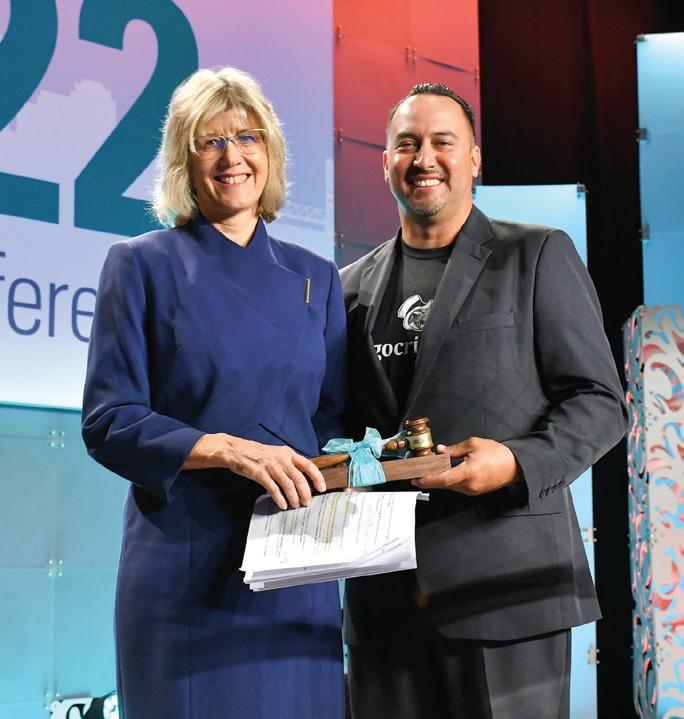

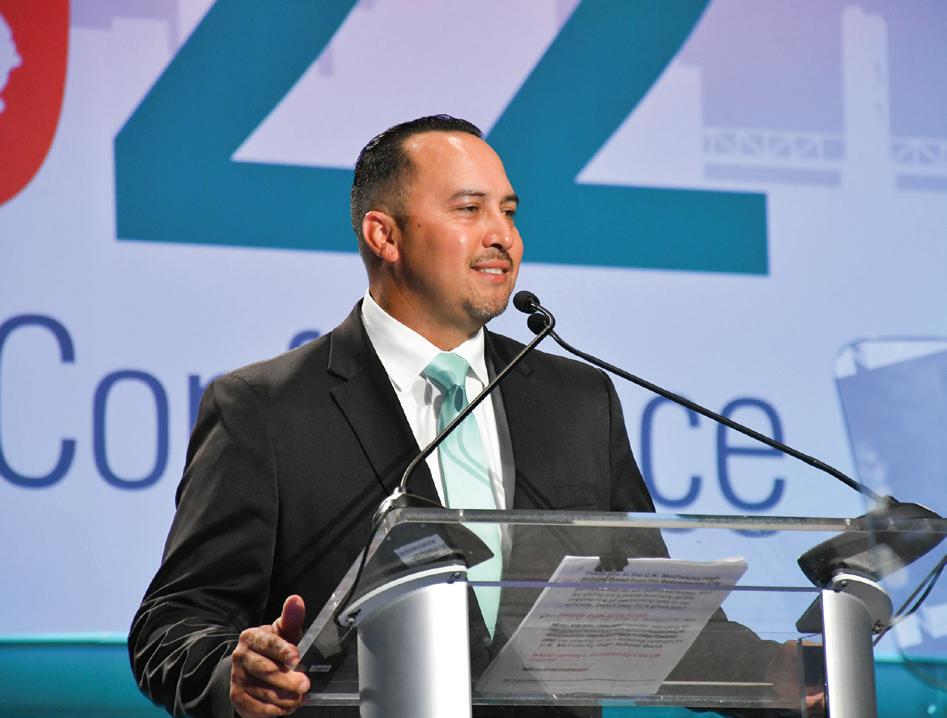
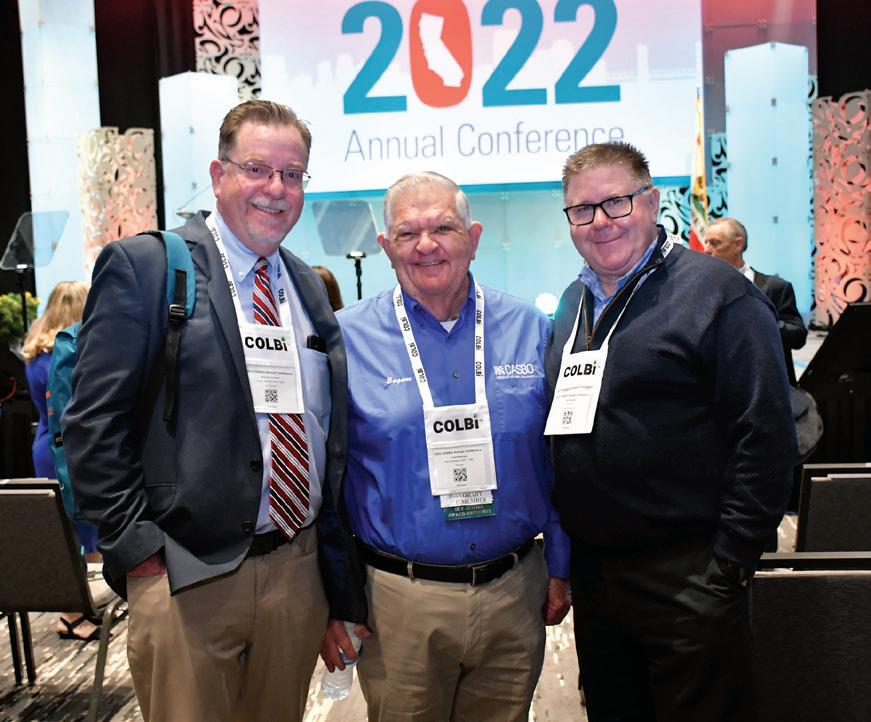


Evolve. Transform.
For three days, we returned to our deep connections and worked to shape the new face of education!
50 California School Business Summer 2022
CASBO’s







California School Business casbo.org 51 OUT & ABOUT










52 California School Business Summer 2022 Plan for Fiscal Challenges Ahead (800) 540-6369 ext. 127 info@pars.org www.pars.org With approaching reserve caps, lack of STRS/PERS relief, declining enrollment, and the pending “fiscal cliff,” now is the time for school districts to plan for what lies ahead. PARS provides innovative solutions that help districts save money, reduce long term liabilites and prepare for a rainy day. Contact us today to learn about our early retirement incentive program, the Supplementary Retirement Plan (SRP), our OPEB/Pension prefunding trust, and other custom solutions to address your specific fiscal and operational challenges. BayAlarm.com/school SECURITY & FIRE SOLUTIONS TO KEEP YOUR STAFF AND SAFE Get a free security review today! Setting the Gold Standard by partnering with over 300 agencies OFFICES Corporate: Anaheim. Regional: Fresno, Indio, Los Angeles, Riverside, Sacramento, San Diego, San Francisco, San Jose, Stockton, Ventura West Coast Arborists, Inc. www.WCAINC.com • ( 8 0 0 ) 5 21 – 3 71 4 Tree Pruning Tree Removal Tree Planting E mergenc y Respons e GPSTree Inventory PlantHe althCare










































































California School Business casbo.org 53 AD INDEX casbo.org > Learn + Grow > Events Get your booth early! CASBO Annual Conference & California School Business Expo April 4 - 7, 2023 Long Beach Convention Center Aeries Software Inc. . . . . . . . . . . 3 Amazon Business . . . . . . . . . . . 18 American Fidelity . . . . . . . . . . . 8 AP Keenan . . . . . . . . . . . . . . 10 ASCIP . . . . . . . . . . . . . . . . 48 Atkinson, Andelson, Loya, Ruud & Romo . . . . . . . . . . 22 Bay Alarm Company . . . . . . . . . . 52 California Schools Joint Powers Authorities (CSRM) . . . . . . .15 California’s Valued Trust . . . . . . . . 17 CDW Government LLC . . . . . . . . . 30 COLBI . . . . . . . . . . . . . . . . . 16 Forecast5 Analytics, a Frontline Education Company . . . . . 14 Horace Mann . . . . . . . . . . . . . 18 Image One . . . . . . . . . . . . . . . 53 Kasdan Turner Thomson Booth LLP . . . 49 KeyAnalytics, a division of California Financial Services . . . . . 20 Office DEPOT . . . . . . . . . . . . . 20 PEPPM . . . . . . . . . . . . . . . . 23 Piper Sandler . . . . . . . . . . . . . 4 Planetbids, Inc. . . . . Inside Back Cover Public Agency Retirement Services (PARS) . . . . . . 52 School Outfitters . . . . Inside Front Cover Schools Excess Liability Fund (SELF) . . . 30 SchoolsFirst Federal Credit Union . . . . 7 Sehi Computer Products, Inc. . . . . . . 49 Self-Insured Schools of California (SISC) . . . . . . . . . . . 31 Sourcewell . . . . . . . . . . . . . . 16 Staples . . . . . . . . . . . . . . . . 22 Stifel, Nicolaus & Company . . . . . . . . . Back Cover West Coast Arborists . . . . . . . . . . 52

54 California School Business Summer 2022 Now Included * With Your Organizational Subscription! Our eLearning platform lets you keep your professional development current, even when you can’t attend a workshop in person! It’s the same quality training you’ve come to rely on from CASBO, only now we deliver it to you at your own convenience. And this year, it’s included* for all of your local education agency’s business services employees as part of our Organizational Subscription. CASBO Online. It’s a new normal. And a new way to learn! To learn more, visit casbo.org > Learn + Grow > CASBO Online *Premium leadership courses not included but available at a subscriber discount.


California School Business casbo.org 55 PlanetBids has helped to completely automate hundreds of agencies, from K-12 to higher educational institutions, including the California State University system and community colleges. Our dashboard of interconnected modules for bidding, pre-quali cation, contracts, e-bonds, reporting and much more is easy to implement and use, and we have received glowing reviews from Procurement, Public Works and Facilities Professionals. PlanetBids’ proprietary and cloud-based PB SystemTM is developed and serviced in California. YEA RS of EXCELLENCE 22 Does your existing procurement process overwhelm you? We have 22 years of proven results in fully automating schools. Visit planetbids.com Schedule a Demo Tod ay ! sales@planetbids.com 888.614.2437
FINANCING CALIFORNIA’S FUTURE
Stifel is the leading underwriter of California K-12 school district bonds.* We assist local districts in providing financing for facility projects and cash flow borrowing, including new construction, modernization, renovation, and technology improvements. Our work with California school districts includes:

■ General Obligation Bonds
■ Mello-Roos Bonds
■ Certificates of Participation/Leases
■ Short-term Notes and TRANs
■ Refinancing or Restructuring of Previously Issued Bonds
We give back to the communities we serve by providing college scholarships to graduating high school seniors through Stifel’s annual Fabric of Society essay competition and by supporting school-related foundations and functions with charitable contributions.
* Source: Thomson Reuters SDC, Ranked No. 1 in California K-12 bonds by par amount and number of issues in 2021 Stifel, Nicolaus & Company, Incorporated | Member SIPC & NYSE | www.stifel.com
56 California School Business Summer 2022
Let us help you achieve your financing goals. Visit www.stifel.com/publicfinance or contact a member of our School Finance Group: Bruce Kerns Managing Director (415) 364-6839 bkerns@stifel.com Erica Gonzalez Managing Director
egonzalez@stifel.com Roberto
Dawn Vincent Managing Director
dvincent@stifel.com Robert Barna Managing Director (213) 443-5205 rbarna@stifel.com Southern California | Los Angeles Office Northern California | San Francisco Office
(415) 364-6841
J. Ruiz Managing Director (415)364-6856 rruiz@stifel.com
(213) 443-5006



















































































































 By Jennifer Fink
By Jennifer Fink






































































